The Agra Fort is another architectural marvel located in Agra, which is best known for the famous Taj Mahal. The vast complex of red sandstone walls, fine sculptures, and historical significance that is Agra Fort is recognised as a UNESCO World Heritage Site. We’ll explore Agra Fort’s rich history, stunning architecture, and cultural significance in this blog post, demonstrating why it should be on every traveler’s itinerary.
A Brief Historical Overview
The original construction of Agra Fort dates back to the early 11th century, under the reign of Rajput monarch Badal Singh. But the fort really came into its own during the reign of Mughal Emperor Akbar.
Between 1556 and 1565, Akbar undertook substantial renovations and expansions to the fort, realising its strategic significance. Shah Jahan and Jahangir, his successors, added more decorations to the fort, turning it into a representation of Mughal grandeur. Because to its advantageous location along the Yamuna River, the fort was a significant military stronghold. It has seen many historical occurrences over the ages, including battles and royal intrigues, making it a veritable gold mine of India’s rich past.
Table of Contents
Architectural Magnificence
The Exterior: Red Sandstone Walls
The striking red sandstone walls that encircle the fort dominate its façade. They are up to 20 meters high and span about 2.5 kilometres. The fort was previously shielded from attackers by these strong walls, which are broken up by imposing gates. The Mughals’ architectural grace and military prowess are also evident in the fort’s architecture.
The Gates: Magnificent Entrances
There are four main gates leading up to Agra Fort, each with a unique historical significance
1. Delhi Gate:- One of the most opulent entrances to the fort, the Delhi Gate was the principal entryway during the Mughal Empire. Its strategic orientation towards Delhi, the capital city, highlighted its significance in Mughal governance.
2. Amar Singh Gate:- An important character in Mughal history, Amar Singh Rathore was the name of this gate. The Amar Singh Gate’s design was less ostentatious than the Delhi Gate’s, indicating its secondary significance.
3. Akbari Gate :- Often referred to as the Southern Gate, this is one of the fort’s most impressive entrances. It is renowned for its intricate carvings and was built by Akbar to showcase his architectural prowess.
4. Jahangiri Gate :- This gate bears the name of Emperor Jahangir and is renowned for its exquisite proportions and elaborate embellishments. Mostly, the royal family and notable visitors used it.
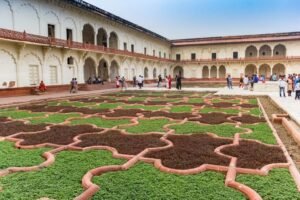
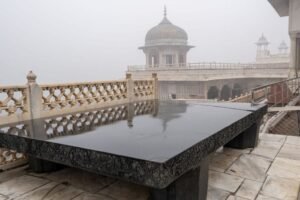
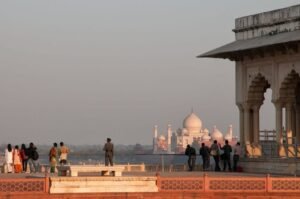
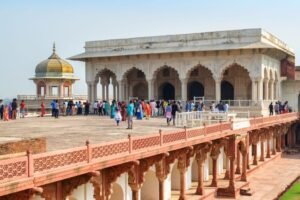
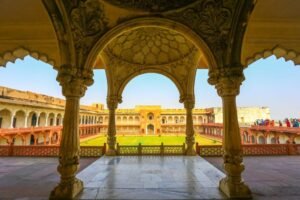
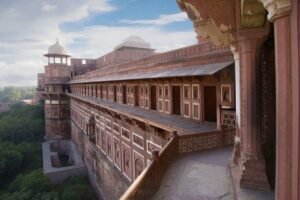
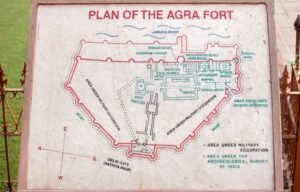
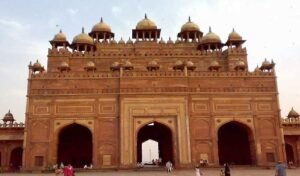
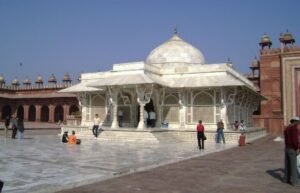
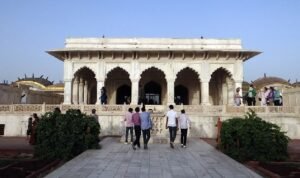
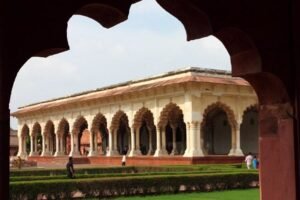
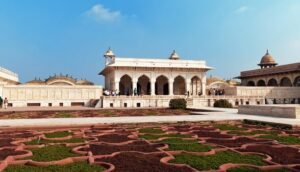
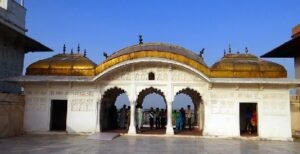
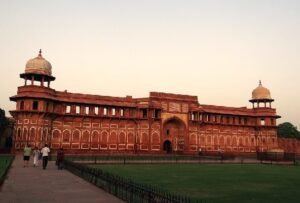
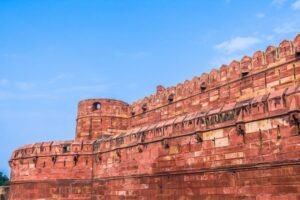
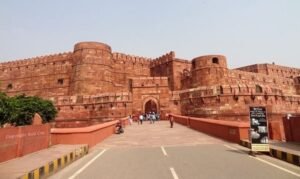
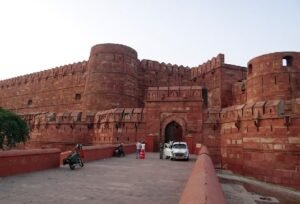

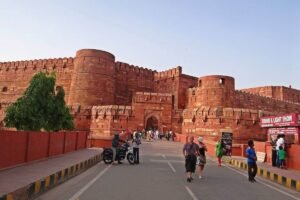
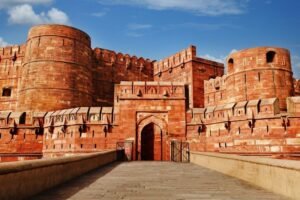
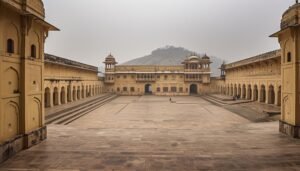
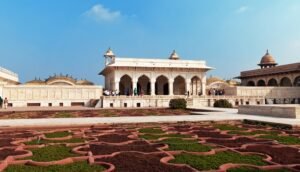


Key Structures Inside the Fort
Upon entering the fort, guests are welcomed by an array of magnificent buildings, each providing an insight into the extravagant lifestyle of the Mughals:
1.Diwan-i-Am (Hall of Public Audience):- Akbar addressed the ordinary people and held state affairs discussions in this magnificent hall. The magnificence of the Mughal court is reflected in its magnificent columns and detailed sculptures.
2.Diwan-i-Khas (Private Audience Hall):- Known for its fine marble craftsmanship and beautiful inlay motifs, this hall is reserved for exclusive meetings and intimate parties. It was in this special meeting room that Emperor Shah Jahan entertained high-ranking officials.
3.Mirror Palace (Sheesh Mahal):- A masterwork of Mughal construction, the Sheesh Mahal is renowned for its mirrored ceiling and walls, which produce a shimmering effect. This palace, one of the most exquisite features of the fort, was created as a refuge for the Mughal emperors.
4.Jahangiri Mahal :- This palace, constructed by Akbar for his adored wife, Mariam-uz-Zamani, is distinguished by its magnificent courtyard and refined sculptures. Its architecture is a fusion of Indian and Persian designs.
5.Moti Masjid (Pearl Mosque):- Built by Emperor Shah Jahan, this mosque is renowned for its immaculate white marble and understated yet exquisite architecture. It is evidence of the Mughals’ commitment and mastery of architecture.
6.Khas Mahal:- The Mughal rulers’ personal abode was the magnificent marble palace known as the Khas Mahal. It is the focal point of the fort because of its exquisite design and stunning surroundings.
Historical Significance
Indian history has been significantly impacted by the Agra Fort. It served as the Mughal Empire’s capital and was the scene of many historical events. A number of Mughal monarchs lived at the fort as well, notably Shah Jahan, who was held captive by his son Aurangzeb. It is reported that Shah Jahan would spend his days in his quarters staring at the Taj Mahal and thinking about the death of his beloved wife.
knowledge the political and cultural history of the Mughal Empire requires a knowledge of the fort’s strategic significance as well as its function in the Mughal administration. Its fusion of military and architectural elements demonstrates the Mughals’ ability to integrate style and utility.
Preservation and Conservation
Maintaining the rich history of Agra Fort has proven to be a constant struggle. To preserve its historical authenticity and structural integrity, the fort has undergone a number of restoration initiatives. The fort’s preservation and the chance for future generations to witness its magnificence are largely due to the work of institutions like the Archaeological Survey of India (ASI).
Visiting Agra Fort: Practical Information
Location and Accessibility
The Taj Mahal is about 2.5 kilometres away from Agra Fort, which is situated in the city’s centre. Numerous transportation options, including as cabs, autorickshaws, and private vehicles, make it easily accessible. The fort is an easy place for travellers to visit because of its excellent rail and road connections.
Entry Fees and Timings
According to the most recent information, foreign visitors must pay INR 650, while Indian nationals must pay INR 40. The best times to visit the fort are in the early morning or late afternoon to avoid the heat and congestion. The fort is open to visitors from sunrise to dusk.
Tips for Visitors
1.Put on Comfortable Shoes :- Due to the fort’s vast grounds, walking is required, therefore comfortable shoes are a must.
2. Bring Water :- It’s critical to stay hydrated, particularly in the summer months.
3. Respect the Rules :- To avoid fines, make sure you abide by the rules regarding photography, as some portions of the fort are off-limits.
4. Guide Services:- By offering in-depth explanations and historical background, hiring a local guide can improve your experience.
Conclusion
Agra Fort is a living reminder of India’s imperial past, waiting to be discovered and appreciated. Whether you are an enthusiast of history, an architecture enthusiast, or just a curious traveler, Agra Fort offers a fascinating glimpse into the opulent world of the Mughals.
As you explore the fort’s majestic halls and serene gardens, take a moment to appreciate the artistry and craftsmanship that have been preserved through centuries of change. Agra Fort is not just a historical monument.








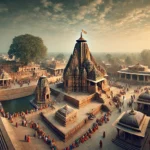

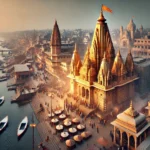

It’s hard to find educated people on this topic,
but you seem like you know what you’re talking about! Thanks
Thank you
Thanks very nice blog!